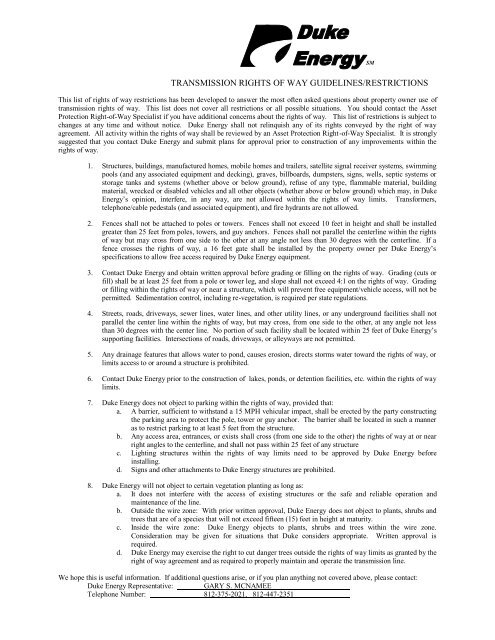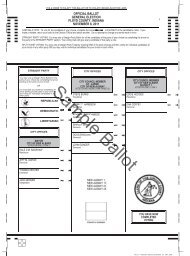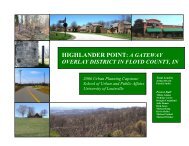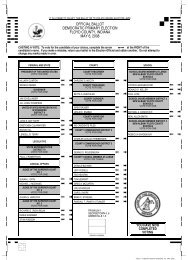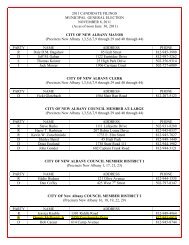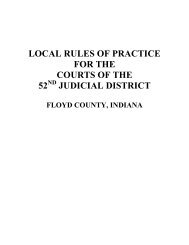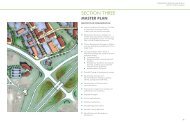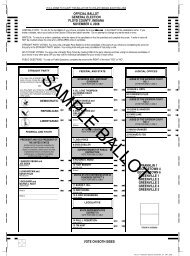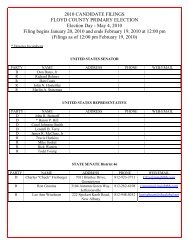Electrical and Inground Pool Permit Application (pdf) - Floyd County ...
Electrical and Inground Pool Permit Application (pdf) - Floyd County ...
Electrical and Inground Pool Permit Application (pdf) - Floyd County ...
You also want an ePaper? Increase the reach of your titles
YUMPU automatically turns print PDFs into web optimized ePapers that Google loves.
SM<br />
TRANSMISSION RIGHTS OF WAY GUIDELINES/RESTRICTIONS<br />
This list of rights of way restrictions has been developed to answer the most often asked questions about property owner use of<br />
transmission rights of way. This list does not cover all restrictions or all possible situations. You should contact the Asset<br />
Protection Right-of-Way Specialist if you have additional concerns about the rights of way. This list of restrictions is subject to<br />
changes at any time <strong>and</strong> without notice. Duke Energy shall not relinquish any of its rights conveyed by the right of way<br />
agreement. All activity within the rights of way shall be reviewed by an Asset Protection Right-of-Way Specialist. It is strongly<br />
suggested that you contact Duke Energy <strong>and</strong> submit plans for approval prior to construction of any improvements within the<br />
rights of way.<br />
1. Structures, buildings, manufactured homes, mobile homes <strong>and</strong> trailers, satellite signal receiver systems, swimming<br />
pools (<strong>and</strong> any associated equipment <strong>and</strong> decking), graves, billboards, dumpsters, signs, wells, septic systems or<br />
storage tanks <strong>and</strong> systems (whether above or below ground), refuse of any type, flammable material, building<br />
material, wrecked or disabled vehicles <strong>and</strong> all other objects (whether above or below ground) which may, in Duke<br />
Energy’s opinion, interfere, in any way, are not allowed within the rights of way limits. Transformers,<br />
telephone/cable pedestals (<strong>and</strong> associated equipment), <strong>and</strong> fire hydrants are not allowed.<br />
2. Fences shall not be attached to poles or towers. Fences shall not exceed 10 feet in height <strong>and</strong> shall be installed<br />
greater than 25 feet from poles, towers, <strong>and</strong> guy anchors. Fences shall not parallel the centerline within the rights<br />
of way but may cross from one side to the other at any angle not less than 30 degrees with the centerline. If a<br />
fence crosses the rights of way, a 16 feet gate shall be installed by the property owner per Duke Energy’s<br />
specifications to allow free access required by Duke Energy equipment.<br />
3. Contact Duke Energy <strong>and</strong> obtain written approval before grading or filling on the rights of way. Grading (cuts or<br />
fill) shall be at least 25 feet from a pole or tower leg, <strong>and</strong> slope shall not exceed 4:1 on the rights of way. Grading<br />
or filling within the rights of way or near a structure, which will prevent free equipment/vehicle access, will not be<br />
permitted. Sedimentation control, including re-vegetation, is required per state regulations.<br />
4. Streets, roads, driveways, sewer lines, water lines, <strong>and</strong> other utility lines, or any underground facilities shall not<br />
parallel the center line within the rights of way, but may cross, from one side to the other, at any angle not less<br />
than 30 degrees with the center line. No portion of such facility shall be located within 25 feet of Duke Energy’s<br />
supporting facilities. Intersections of roads, driveways, or alleyways are not permitted.<br />
5. Any drainage features that allows water to pond, causes erosion, directs storms water toward the rights of way, or<br />
limits access to or around a structure is prohibited.<br />
6. Contact Duke Energy prior to the construction of lakes, ponds, or detention facilities, etc. within the rights of way<br />
limits.<br />
7. Duke Energy does not object to parking within the rights of way, provided that:<br />
a. A barrier, sufficient to withst<strong>and</strong> a 15 MPH vehicular impact, shall be erected by the party constructing<br />
the parking area to protect the pole, tower or guy anchor. The barrier shall be located in such a manner<br />
as to restrict parking to at least 5 feet from the structure.<br />
b. Any access area, entrances, or exists shall cross (from one side to the other) the rights of way at or near<br />
right angles to the centerline, <strong>and</strong> shall not pass within 25 feet of any structure<br />
c. Lighting structures within the rights of way limits need to be approved by Duke Energy before<br />
installing.<br />
d. Signs <strong>and</strong> other attachments to Duke Energy structures are prohibited.<br />
8. Duke Energy will not object to certain vegetation planting as long as:<br />
a. It does not interfere with the access of existing structures or the safe <strong>and</strong> reliable operation <strong>and</strong><br />
maintenance of the line.<br />
b. Outside the wire zone: With prior written approval, Duke Energy does not object to plants, shrubs <strong>and</strong><br />
trees that are of a species that will not exceed fifteen (15) feet in height at maturity.<br />
c. Inside the wire zone: Duke Energy objects to plants, shrubs <strong>and</strong> trees within the wire zone.<br />
Consideration may be given for situations that Duke considers appropriate. Written approval is<br />
required.<br />
d. Duke Energy may exercise the right to cut danger trees outside the rights of way limits as granted by the<br />
right of way agreement <strong>and</strong> as required to properly maintain <strong>and</strong> operate the transmission line.<br />
We hope this is useful information. If additional questions arise, or if you plan anything not covered above, please contact:<br />
Duke Energy Representative: GARY S. MCNAMEE<br />
Telephone Number: 812-375-2021, 812-447-2351


